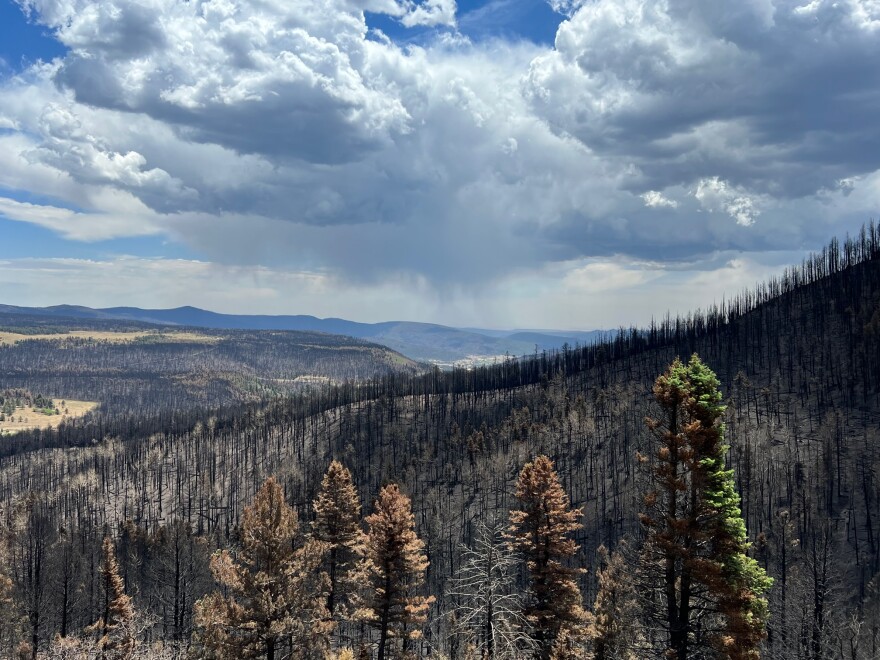One year ago today, a prescribed burn by the US Forest Service escaped and was declared to be the Hermit's Peak wildfire. It would later combine with another planned burn that got out of control, the Calf Canyon Fire, to become New Mexico's largest recorded wildfire.
The fire's impact rippled out from the hundreds of families who lost homes, to state government and even Congress. Politicians passed laws to compensate victims and try to stop this happening again.
KUNM's Alice Fordham is reporting in the fire zone on its enduring impact. She spoke with All Things Considered host Nash Jones.
ALICE FORDHAM: I made a trip I've made many times over the last year to Las Vegas and then up to Mora. You never forget that the fire happened. There are big charred patches on the mountainside and sometimes all the way up to the side of the road. There are sandbags around most buildings because there's been persistent flooding on burn scars.
But it's when you talk to people that it becomes most apparent that life hasn't gone back to normal for hundreds or thousands of families. Let me tell you about one lady I met today, Norma Romero. I went up to her property near the town of Chacon and she pointed out the burned parts of the forest behind her home.
NORMA ROMERO: Okay, so the fire was up to right there.
FORDHAM: And she showed me where the floods went.
ROMERO: And you can see on the wall on my mom's house, how high the water was coming. Do you see it, that shadow? And it damaged everything, everything, all our trees and river. It came into my porch, in the back door.
FORDHAM: So there's the physical damage, but then there's the trauma as well.
ROMERO: I still think about it at night. You know, it's like, you know, get up sometimes at night, listen to see how fast the water's coming in the ditch.
FORDHAM: And Norma takes care of her daughter, Leaondra, who has an intellectual disability and she says when it gets rainy Leaondra doesn't want to be in the house at night. She's scared.
KUNM: We reported when the federal government took responsibility for the fire because it was accidentally started by a federal agency. What does that mean on the ground? Are people like Norma and her family getting compensation?
FORDHAM: So there's a big expensive effort that is meant to compensate people fully, but a lot of people are affected by the fire say they are confused by it and it's not moving very fast. The basics are that the federal government appropriated that massive sum of nearly $4 billion, and it's given FEMA, the Federal Emergency Management Agency, the job of figuring out how the claims process will work and what the rules will be.
People can't actually file claims yet, the rules aren't finalized, but FEMA officials are starting to get in touch with people about how the process can begin. One striking aspect of this is that during FEMA's initial response, a lot of people said the agency didn't really understand a lot of things specific to this area, like acequias, for example, or grazing and logging rates in the National Forest. So now FEMA has hired some staff from New Mexico, including Paula Gutierrez. She's actually from Santa Clara Pueblo, and her role is to advocate for claimants. I spoke to her about the way of life that people are trying to get back.
PAULA GUTIERREZ: It's maximizing all the different natural resources that currently exist within the forested lands. It's living off the land. We grow our own food, we utilize the land, we utilize the acequias to be able to bring water to our agricultural fields. You know, we go hunting, we're hunters.
FORDHAM: And she also said she sees how confusing FEMA is for people and she wants to be proactive in helping people make claims. The agency ultimately expects as many as 30,000 claims.
KUNM: Well, then now we're coming into wildfire season again, winds are picking up. How likely is it that a fire like this could happen again?
FORDHAM: Well, in Mora I was speaking to people who are hopeful that a wet winter could mean the vegetation isn't as dry, that the fire risk isn't as high this year. More broadly, though, this fire prompted a number of policy changes. The Forest Service paused planned burns entirely for a few months then brought them back but with tighter restrictions. And this week, the governor signed into state law a restriction on planned burning during red flag days when the wind is the highest. But as the climate changes, managing fire risk is going to continue to be vital and likely very difficult.




